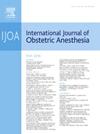Effect of prophylactic intravenous calcium gluconate on uterine atony during intrapartum cesarean delivery with spinal anesthesia: a placebo controlled, randomized clinical trial
IF 2.3
3区 医学
Q2 ANESTHESIOLOGY
引用次数: 0
Abstract
Background
Nearly two-thirds of postpartum hemorrhage is due to uterine atony. Calcium ions play a vital role in myometrial contraction and may improve uterine tone. However, studies utilizing calcium to prevent uterine atony are limited, and have yielded conflicting findings. We designed this study to evaluate the effect of prophylactic intravenous calcium on uterine tone during intrapartum cesarean delivery with spinal anesthesia.
Method
This prospective, randomized, placebo-controlled, two-arm blinded trial was performed in patients undergoing intrapartum cesarean delivery with spinal anesthesia. Patients were randomized to receive intravenous calcium gluconate 1 g (93 mg elemental calcium) or placebo (normal saline) over 10 minutes after umbilical cord clamping. The primary outcome measure was uterine tone, assessed five times by the obstetrician using an 11-point verbal numeric rating score (0 = completely atonic; 10 = fully contracted). Secondary outcomes were postpartum blood loss, additional uterotonic administration, and blood product transfusion.
Result
Three hundred sixty-seven patients (183 in the calcium group and 184 in the placebo group) participated in the trial. Demographic variables were comparable. The uterine tone score (mean ± standard deviation) increased from baseline by 2.67 ± 0.97 in the calcium group and by 2.79 ± 0.98 in the placebo group, respectively (P =0.11). The uterine tone score (median with range) 10 minutes after the end of study drug infusion was 8 (6–10) in the calcium group vs. 8 (4–10) in the placebo group (P =0.002) However, the postpartum blood loss was significantly lower in the calcium group (526.0 ± 155.2 vs. 581.5 ± 148.9 mL; mean difference of 55.6 mL; 95% CI 24.3 to 86.8, P =0.001). Additional uterotonic administration was lower in the calcium group (21.7% vs. 42.39%; RR was 0.51; 95% CI 0.37 to 0.71, P =0.001). Nonetheless, transfusion and vasopressor requirements were comparable.
Conclusion
Intravenous calcium gluconate (1 g) did not improve uterine tone, evaluated by the obstetricians with a numeric rating score, during intrapartum cesarean delivery with spinal anesthesia, though it significantly reduced additional uterotonics administration.
The trial was registered at the clinical trial registry of India (CTRI/2022/12/047912) on 06/12/2022.
预防性静脉注射葡萄糖酸钙对脊髓麻醉剖宫产术中子宫张力的影响:一项安慰剂对照的随机临床试验
近三分之二的产后出血是由子宫张力引起的。钙离子在子宫肌收缩中起着至关重要的作用,并可能改善子宫张力。然而,利用钙来预防子宫张力的研究是有限的,并且产生了相互矛盾的发现。本研究旨在探讨脊髓麻醉下剖宫产术中预防性静脉补钙对子宫张力的影响。方法采用前瞻性、随机、安慰剂对照、双臂盲法,对脊柱麻醉下剖宫产患者进行研究。患者在脐带夹紧后10分钟内随机接受葡萄糖酸钙1 g (93 mg元素钙)或安慰剂(生理盐水)静脉注射。主要结局指标是子宫张力,由产科医生使用11分口头数字评分评估5次(0 =完全无张力;10 =完全收缩)。次要结局是产后失血、额外的子宫强张剂和输血。结果367例患者(钙组183例,安慰剂组184例)参加了试验。人口统计变量具有可比性。对照组子宫张力评分(均数±标准差)较基线分别提高2.67±0.97和2.79±0.98 (P =0.11)。研究药物输注结束后10分钟,钙组子宫张力评分(中位范围)为8分(6-10分),安慰剂组为8分(4-10分)(P =0.002),但产后出血量明显低于钙组(526.0±155.2比581.5±148.9 mL;平均差值55.6 mL;95% CI 24.3 ~ 86.8, P =0.001)。补钙组额外子宫扩张给药率较低(21.7% vs. 42.39%;RR为0.51;95% CI 0.37 ~ 0.71, P =0.001)。尽管如此,输血和血管加压素的需求是相似的。结论:经产科医生评定,腰麻剖宫产术中静脉滴注葡萄糖酸钙(1g)并不能改善子宫张力,但可以显著减少额外的子宫强张给药。该试验于2022年6月12日在印度临床试验注册中心注册(CTRI/2022/12/047912)。
本文章由计算机程序翻译,如有差异,请以英文原文为准。
求助全文
约1分钟内获得全文
求助全文
来源期刊
CiteScore
4.70
自引率
7.10%
发文量
285
审稿时长
58 days
期刊介绍:
The International Journal of Obstetric Anesthesia is the only journal publishing original articles devoted exclusively to obstetric anesthesia and bringing together all three of its principal components; anesthesia care for operative delivery and the perioperative period, pain relief in labour and care of the critically ill obstetric patient.
• Original research (both clinical and laboratory), short reports and case reports will be considered.
• The journal also publishes invited review articles and debates on topical and controversial subjects in the area of obstetric anesthesia.
• Articles on related topics such as perinatal physiology and pharmacology and all subjects of importance to obstetric anaesthetists/anesthesiologists are also welcome.
The journal is peer-reviewed by international experts. Scholarship is stressed to include the focus on discovery, application of knowledge across fields, and informing the medical community. Through the peer-review process, we hope to attest to the quality of scholarships and guide the Journal to extend and transform knowledge in this important and expanding area.

 求助内容:
求助内容: 应助结果提醒方式:
应助结果提醒方式:


